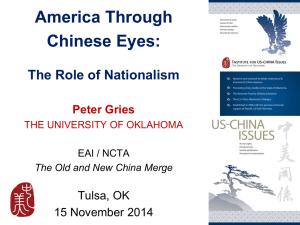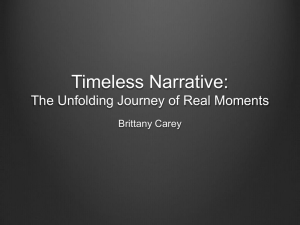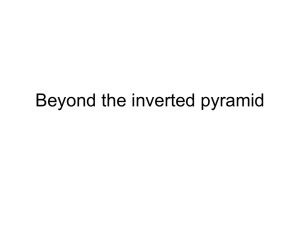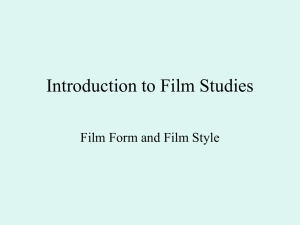Realism in Classical American Film
advertisement
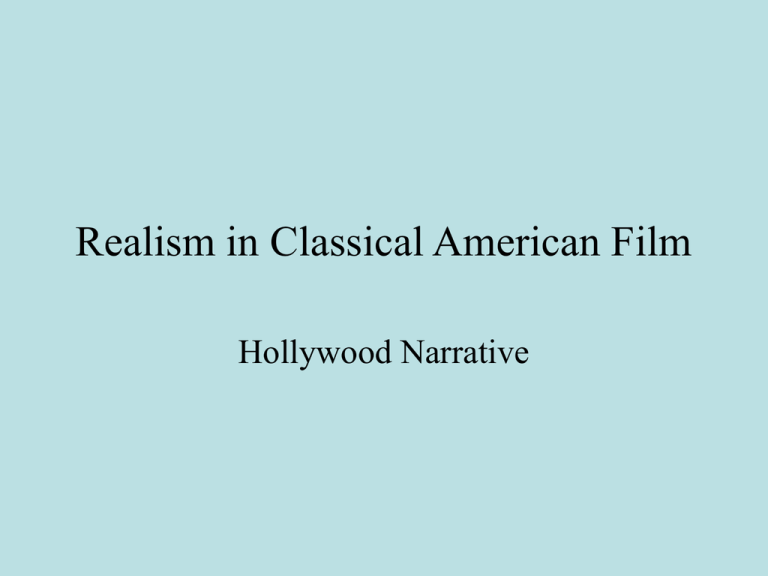
Realism in Classical American Film Hollywood Narrative Table of Contents 1 Realistic Narrative 2 Non-realistic Narrative 3 Purer Form of Realist Narrative Narrative • Narrative - structured or constructed story which tells fictional or non-fictional events. • Narration – an act of narrating, telling a narrative • Narrator - the one who tells a narrative (generally by voice-over in the case of cinema) • Narratology - study on narrative, narration and narrator. Realistic Narrative • The most important component of Classical American Films is ‘narrative’ (story). • The bottom line - their narratives are constructed in such a way that they give the viewer an impression that he/she is watching something ‘real’ - render ‘reality’ and ‘truth’ effects. Realistic Narrative • The classical Hollywood film achieves reality and truth effects by concealing artistry. • → Narrative and narration, too, like various filming techniques, must be 'invisible' and unobtrusive so that most viewers barely notice its technique and artistry. Realistic Narrative • Narrative techniques and devices which are employed to make themselves invisible: • Formulae -CHRONOLOGICALITY and CAUSALITY • CHRONOLOGICAL - events occur in a 1-2-3 order (occasional flashbacks - the only permissible manipulation) Realistic Narrative Formalistic Narrative • Christopher Nolan’s Memento (2000) • The entire story is told in backward ( from the present to the past). • Leonard, as a result of a blow received on his head during an assault on him, he has no short term memory. Realistic Narrative • He is looking for the real killer of his wife, with the assistant of a Polaroid camera and tattooing on himself the important facts he finds. Each scene the viewer watches is one earlier than the last one he/she has watched. Realistic Narrative • CAUSAL - actions are joined together as a series of CAUSES and EFFECTS • 'Plot is a careful and logical working out of the laws of cause and effect. The mere sequence of events will not make a plot. Emphasis must be laid upon causality, and the action - reaction of the human will.' Francis Patterson, 'Manual for Aspiring Screenwriters', 1920 Realistic Narrative • e.g. A storm isolate a group of characters; a war separate lovers; a lack of care kills tropical fish; a cheat leads to a divorce; a betrayal prompts a revenge. Realistic Narrative • Mulholand Drive (2001) - divided into two main sections: the first, which could be interpreted as a dream (1 hour 56 minutes) and the final 25 minutes. Important events in the first section are repeated in the second section, but with significant differences. Realistic Narrative • Different characters repeat the same actions, and these different characters are played by the same actors. Furthermore, the important events in the first part are mysterious, but there is a more mundane repetition of them in the second half. Realistic Narrative • There is not much logic of cause and effect in the first section. The lack of causality is compensated by the repetition, which gives the film more textual coherence. Realistic Narrative • COINCIDENCE • According to the Hollywood ‘formula’ coincidence should be confined to the initial situation • The later in a film a coincidence occurs, the weaker it is - the loss of credibility Realistic Narrative • A case in which a coincidence takes place in the middle of a film. • Alfred Hitchcock’s The Birds (1963) Realistic Narrative • Actions must have their MOTIVATIONS • One must have a good reason for what one does. • When an action is unmotivated, it would lose its credulity Realistic Narrative • 'In order that the motion picture may convey the illusion of reality that audiences demand, the scenario writer stresses motivation - that is, he makes clear a character's reason for doing whatever he does that is important.' Frances Marion, 'Scenario Writing' 1938 Non-realistic Narrative • Complete ignoring of the narrative formula in classical American films • Chronologicality, causality, motivation Non-realistic Narrative • Surrealist film by Louis Bunuel designed by Salvatore Dali • Un Chien Andalou (1929) Illusion of Reality in Realist Narrative • The film drama is: ‘… LIFE WITH THE DULL BITS CUT OUT’ (Alfred Hitchcock) Illusion of Reality in Realist Narrative • Classical realist narrative is NOT retelling of what happens in reality because it extracts from the world of its characters almost only elements which are relevant to its progress. • The realistic narrative in classical American films, which is achieved through various techniques and devices, is the one which gives the viewer reality and truth effects, but is not exactly real. Purer Form of Realist Narrative • Purer form of realism in narrative is found in non-diegetic elements. • Diegetic - being relevant to the progress of a story • Non-diegetic - being irrelevant to the progress of an imaginary story Purer Form of Narrative • Siegmund Kracauer finds an inverted relation between those images that further the story and those ‘retain a degree of independence of the intrigue and thus succeed in summoning physical reality.’ Purer Form of Narrative • Roland Barthes characterizes literary reference to objects that have no discernible narrative function except to give a material, worldly weight to the description as ‘reality effects. Purer Form of Narrative • A purer form of film realism is found in an incidental or contingent element in narrative. ‘… in the middle of the chase the little boy suddenly needs to piss. So he does.’ (André Bazin) • Vittorio de Sica’s Ladri di biciclette (1948)
